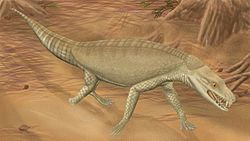| Sphagesauridae Temporal range: Turonian – Maastrichtian | |
|---|---|
 | |
| Life restoration of Armadillosuchus arrudai | |
| Scientific classification | |
| Domain: | Eukaryota |
| Kingdom: | Animalia |
| Phylum: | Chordata |
| Class: | Reptilia |
| Clade: | Archosauria |
| Clade: | Pseudosuchia |
| Clade: | Crocodylomorpha |
| Clade: | Crocodyliformes |
| Clade: | † Notosuchia |
| Clade: | † Sphagesauria |
| Family: | † Sphagesauridae Kuhn, 1968 |
| Genera | |
| |
Sphagesauridae is a Gondwanan family of mesoeucrocodylians that lived during the Late Cretaceous. It was a clade of terrestrial crocodilians that evolved very mammal-like teeth and jaws. [1] [2] Both Sphagesaurus and Adamantinasuchus are known from the Turonian to Santonian of Brazil. [3] [4]
